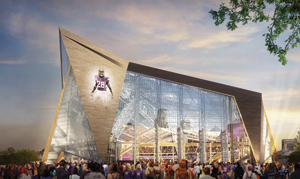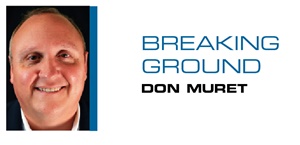The only people happier than the San Francisco 49ers over the
Levi’s Stadium naming-rights deal were the guys who make their living brokering those types of agreements.
Rob Yowell, Jeff Marks and Jeff Knapple, three consultants whom major league teams hire to help sell naming rights for sports facilities, were understandably upbeat after hearing that the 49ers had signed Levi’s to a 20-year, $220 million deal for their new stadium, set to open in 2014.
“The numbers reported are good for everybody,” said Knapple, executive vice president of Van Wagner Sports and Entertainment, the firm hired by the Minnesota Vikings to market their $975 million stadium project, including its naming rights. “It’s another positive sign for the industry as it continues to recover.”
Yowell, president of Gemini Sports Group, who worked on naming rights for Oracle Arena in Oakland and Heinz Field in Pittsburgh, among other deals, agreed with Knapple.
“It’s great for our business that deals are still getting done,” Yowell said. “It’s a good day in the sports sponsorship business when that one comes off the board. The competition [for naming rights among big league venues] just dropped.”
Marks, whose firm, Premier Partnerships, is pitching naming rights to the Rose Garden in Portland as well as for the field at the University of California’s Memorial Stadium, thinks the Levi’s deal will lead to more agreements announced in 2013.
“This is a validation that companies are back in the market buying naming rights because the media value and ROI is meaningful and measurable,” Marks said.
Keeping in mind the nature of the naming-rights business, there will always be skeptics who point to the concept as a “waste of corporate money and a bad spend,” Yowell said. He hopes the strength and longevity of the Levi’s brand tied to the resurrection of the 49ers’ on-field performance will put some of that criticism to rest.
“I’m sure our friends in Minnesota are watching closely, and in Atlanta,” Yowell said, noting the Falcons’ $1 billion new stadium development. “It’s real estate, and we [as brokers] live in it every day.”
 |
The Vikings’ new stadium design was unveiled last week.
Image: HKS |
> VIKINGS’ SHIP: The Minnesota Vikings’ new stadium represents the first NFL facility developed post-recession as architects make adjustments to fit tighter budgets, said
Bryan Trubey,
HKS’s lead designer for the project.
“We’re going through a transition period in our business,” Trubey said last week after the Vikings stadium design was unveiled in Minneapolis. “These are a new generation of buildings after the recession that have made it difficult to finance.”
For example, instead of designing a retractable roof that could have eclipsed the stadium’s fixed budget of $690 million, HKS designed a transparent roof covering that gives Vikings fans the feeling of being outdoors in an indoor facility. HKS was able to convince Vikings ownership that the concept would work, compared with the cost-prohibitive design of a retractable roof, which in a harsh winter climate would most likely have been closed for most Vikings home games.
“In Minnesota, it was the right solution regardless of the budget,” Trubey said. “It makes it far more interesting than if it was a retractive opening. It gives them the sense of an open-air building without the temperature issues.”
In addition, Trubey, designer of both Cowboys Stadium and Lucas Oil Stadium, said the region’s Nordic heritage tied to the team’s nickname represents one of the strongest co-branding opportunities in the NFL.
“That’s why people say they see a Viking ship and an ice formation in the exterior design,” Trubey said.
Others saw a connection to the Crystal Cathedral of television evangelism fame with all the glass and the sharp angles and the slopes and peaks of the stadium’s roof structure.
That’s OK, too, Trubey said. After all, there is something to be said for connecting a pair of traditional Sunday activities.
Don Muret can be reached at dmuret@sportsbusinessjournal.com. Follow him on Twitter @breakground.





